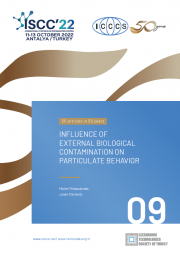INFLUENCE OF EXTERNAL BIOLOGICAL CONTAMINATION ON PARTICULATE BEHAVIOR
Authors:
Michel Thibaudonab, Julien ClertantcKeywords:
Cleanroom, contamination, outdoor, indoor, CoriolisAbstract:
Seasonal Biocontamination is frequently observed both inside cleanrooms and in/on the product. When carrying out sampling of the cleanroom environment, it is necessary to alsosample the outside environment. High levels of pollen and fungal spores outdoors in summer and autumn can correlate to detection of such contaminants inside the clean airlock and
even inside the cleanroom, if appropriate non-cultural methods of detection are used for their detection, whereas classic culture methods are ineffective. Monitoring on a daily or weekly
basis with appropriate method, it is easy to correlate outside levels of pollen and fungal spores with impact inside the installation, and identify the principal mode of transmission as
the personnel, the devices, etc. This enables optimization of gowning and cleanroom cleaning practices to maintain effective control in response to the challenge.
Article:
Although the phenomenon is little known, particulate contamination of clean rooms has a seasonality in line with that of the plants surrounding the building. One study
highlights the importance of continuous control measures, to be implemented taking into account this periodicity in order to maintain the effectiveness of the control of
contamination intact.
It is very rare to hear about the relationship between outdoor weather conditions and the risks of contamination in clean rooms. Indeed, both the temperature, wind
and precipitation conditions and the seasonality of vegetation play an important role in the concentration of external air in biological particles (spores, molds, pollen) (see
Figure 1).

While clean room air handling systems are designed to meet requirements regardless of the concentrations of biological particles in the atmosphere, the entire
process environment is affected by these contaminants. Normally the "personal" and "hardware" airlocks are designed to limit these transfers of contaminants, but often it
is a statistical and not a total elimination. As a result, personnel entering the airlock remain covered with biological particles, potential contaminants. The only setting up
of protective clothing leaves a risk of suspending these particles in the air of the airlock and on the surfaces of stored articles.
Similarly, in the "material" airlock, even advanced disinfections leave the possibility of transferring particles to the clean rooms. And the greater is the external
concentration, the greater is the risk of transfer by staff and consumables, especially when the process requires a large staff and abundant consumables.
 Click to Download PDF
Click to Download PDF
